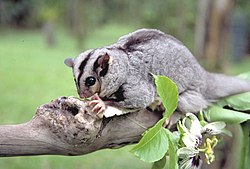But a petaurist isn't a tightrope walker. Show one a tightrope and the chances are it'll do something entirely different.
So what does a petaurist do?
It glides:

Illustration by Richard Lydekker. This type of petaurist is also known as a sugar glider.
Here's another petaurist:

That's a mahogany glider. It's endangered, so admire it while you can.
Petaurists are marsupials, native to Australia and New Guinea, and there are six species, all quite small (perhaps 40cm including the tail). They can't fly, but by using the flaps of skin between their front and back legs they can glide as much as 140m.
This is the reason they don't need to walk along tightropes.
They're also known as flying phalangers.
Flying phalanger, sugar glider, fluffy glider, mahogany glider...
...why on earth has someone landed the poor creatures with a name like petaurist?
Sunday Rest: petaurist. The scientific name of the glider genus, Petaurus, was given to them by an Englishman, George Shaw.
As far as I can discover he only knew gliders from their skins.

George Shaw.
No comments:
Post a Comment
All comments are very welcome, but please make them suitable for The Word Den's family audience.